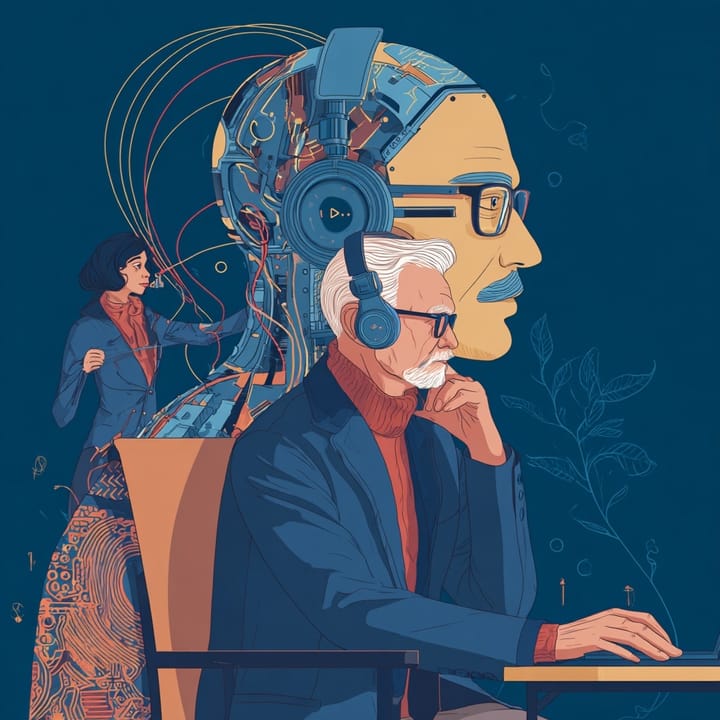Law Six in Clinical AI Healthcare Excellence: Failure Can Fuel Innovation
Accepting the possibility of failure in healthcare AI encourages all of us to strive for greater innovation and potential.

What if the very thing we fear most in medicine—failure—holds the key to unlocking true innovation in healthcare AI? In an industry where patient safety is paramount, we're rightly trained to avoid failure. Yet, this necessary caution can inadvertently paralyze the development of AI before it even begins. Law Six in Clinical AI Healthcare Excellence invites us to reframe how we think about failure, not as a threat to safety, but as a powerful catalyst for discovery when it happens in the right context.
Let’s be clear: failure in clinical deployment is unacceptable. But failure in prototyping, sandbox testing, and early-stage experimentation is not only acceptable, it’s required.
As the Harvard Digital Design Lab notes, “High-impact AI innovation rarely emerges from environments that penalize early-stage failure. Clinical AI must learn to fail forward—ethically, rapidly, and outside of patient-facing systems” (Bzdok et al., 2024).
When I first developed my patient support agent, Emma, a fellow chronic health patient and consultant, asked me, "Are you prepared to accept that your concept might fail?" To be candid, I was shocked. Emma was only in Alpha release, so I knew I had a long way to go, but what did she mean by failure? As an experienced consultant, failure just wasn't something I was used to experiencing. However, her comment made me stop and consider, what if my project failed? Was this a disaster or an opportunity to learn and grow? Those words of wisdom spurred even greater innovation. When I accepted that I could fail, I reached even further and created a better tool that has helped more people. It also made me a wiser consultant.
Why Playing It Safe Can Be Dangerous
Much of healthcare AI today is shaped by an unspoken bias toward low-risk, incremental tools. Think of ambient scribing, appointment routing, or radiology triage, applications that are clinically safe, easily quantifiable, and attractive to investors.
But here’s the paradox: the most clinically meaningful challenges, chronic pain, rare diseases, and mental health disparities, are also the least explored. Why? Because they’re messy. They require creativity, humility, and the willingness to try things that might not work at first. For instance, if AI models are predominantly trained on data from specific racial groups, neglecting the nuances present in others, their 'safe' deployment might inadvertently exacerbate existing health disparities by misdiagnosing or providing suboptimal care for underrepresented populations, thereby failing to address systemic inequities.
Avoiding risk in early-stage development doesn’t protect patients. It protects mediocrity.
A Historical Reminder: Innovation Needs Room to Fail
History is full of life-changing discoveries that emerged from early missteps. Penicillin was discovered after a “failed” bacterial culture. The MRI began as an experimental physics project ridiculed by mainstream medicine. Robotic surgery was once dismissed as unreliable, until repeated trial and error led to the da Vinci system’s eventual approval and widespread adoption.
Failure didn’t derail these breakthroughs—it shaped them. It revealed what didn’t work and pointed toward what might.
In AI development, the same logic applies. A model that misclassifies 30% of rare disease cases in its first iteration is not broken—it’s informative. That “failure” tells us where to look, what data we’re missing, and how our assumptions need to change.
The Research Case for Learning Through Failure
Academic literature reinforces this reality. In a 2023 study published in npj Digital Medicine, Rajkomar et al. found that AI tools that underwent multiple “non-deployment-ready” iterations achieved 34% greater clinical impact post-deployment than tools rushed to market without iterative testing.
MIT’s CSAIL team has shown that early and frequent failure in algorithmic experimentation is a leading predictor of long-term robustness, particularly when designing for complex, underserved conditions like autoimmune disease or chronic fatigue syndrome.

Failure is not a sign to stop; it’s a signal to refine. Failure points are logged and categorized by type, revealing patterns that guide subsequent model improvements, transforming each misstep into a quantifiable source of institutional intelligence.
A Personal Reflection: Risk on the Right Side of the Equation
As someone living with a chronic neurological condition, I’ve often been excluded by AI systems that weren’t trained on patients like me. I’ve had algorithms ignore atypical symptoms, dismiss rare presentations, or confidently deliver the wrong recommendations.
We need systems that are willing to fail in the lab so they can succeed at the bedside. The worst kind of AI failure isn’t a glitch in early testing—it’s a system that never tried to help patients like me at all.
Sandboxes, Simulations, and Structured Risk
So, how do we encourage failure without risking patient harm? The answer lies in structured innovation ecosystems:
- Regulatory firewalls separate experimental models from clinical tools. The FDA’s 2024 guidance on Predetermined Change Control Plans (PCCPs) explicitly allows for “sandbox iteration” without affecting real-world systems.
- Synthetic datasets and de-identified patient records enable stress testing in simulated environments. Stanford Medicine’s AIMI initiative has pioneered this approach, showing how controlled failure can surface flaws before deployment.
- Embedded evaluation frameworks such as those used by UCSF’s AI validation lab assign “learning value” to failure events—quantifying what went wrong, why, and how it informs next steps.
Failure, when contained in these environments, becomes a source of institutional intelligence rather than shame.
Organizational Culture: Making Room for Productive Failure
Creating space for intelligent failure requires more than tools—it demands a cultural shift. Healthcare organizations must:
- Incentivize cross-disciplinary collaboration during experimentation phases.
- Reward validated learnings from “failed” experiments, not just commercial wins.
- Track progress by knowledge gained, not just deployment achieved.
McKinsey’s 2024 outlook on generative AI warns that “the next decade of healthcare AI success will depend less on technical prowess and more on leaders who embrace ethical risk-taking and knowledge iteration.”
What Happens When We Don’t Try
It’s not just that safe-only strategies slow innovation—they actively widen gaps. If AI developers only work on use cases that guarantee success, they will continue to ignore:
- Patients with rare or overlapping diagnoses
- Conditions with unstructured or ambiguous data
- Needs with low commercial ROI but high human cost
This is what happened to a friend of mine with a rare metabolic disorder. They waited three years for a diagnosis. Three years of clinical limbo. Had early-stage AI models been tested—even imperfect ones—they might have surfaced the right pattern earlier. However, no one wanted to take the risk of being wrong, leaving countless patients, like my friend, in a diagnostic void that AI, if responsibly experimented with, could have potentially bridged.
When AI Fails—Safely—Patients Ultimately Win
Innovation is never born fully formed. The stethoscope was once mocked. Laparoscopic surgery was once dismissed as unsafe. The same will be true for AI.
A 2024 analysis in The Lancet Digital Health showed that the highest-impact clinical AI systems—those reducing maternal mortality and racial care disparities—had the most failure events during early development. Their strength came from surviving refinement.
Failure, when honored and learned from, becomes a clinical asset.
Conclusion
Failure is not a bad word in healthcare AI—it’s a signal of ambition. It means we are reaching beyond convenience, beyond commercial comfort, and into the messy, unsolved terrain of real patient lives.
By confining failure to safe environments and embracing it as a form of structured learning, we unlock AI’s power to solve the hardest problems in medicine.
The true revolution in patient care won't be sparked by caution, but by the courage to confront the complex, to try, to learn, and, crucially, to fail—ethically, openly, and relentlessly—until we build the systems that truly serve all.
About Dan Noyes
Dan Noyes operates at the critical intersection of healthcare AI strategy and patient advocacy. As a Certified Patient Leader and Healthcare AI Consultant, his perspective is informed by both professional insight and lived experience with a chronic medical condition. Dan holds advanced certifications from Stanford, Wharton, Google Cloud, and Johns Hopkins, and has helped shape AI projects that center real-world impact and human dignity.
References
Bzdok, D. et al. (2024). The unmet promise of trustworthy AI in healthcare. Frontiers in Digital Health.
Rajkomar, A. et al. (2024). Ethical debates amidst flawed healthcare artificial intelligence metrics. npj Digital Medicine.
FDA (2024). Final Guidance on Predetermined Change Control Plans.
Liu, X. et al. (2024). Responsible and evidence-based AI: 5 years on. The Lancet Digital Health.
MIT CSAIL (2023). Failing Forward: Rethinking Risk in Clinical AI Prototyping.
McKinsey & Company (2024). Generative AI in Healthcare: Trends and Outlook.
Stanford AIMI. (2024). Responsible AI Implementation Framework.


